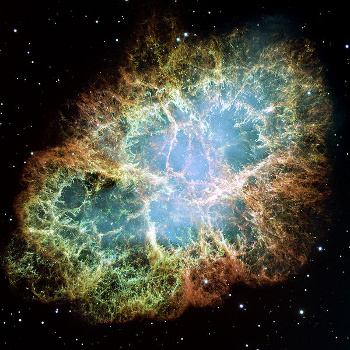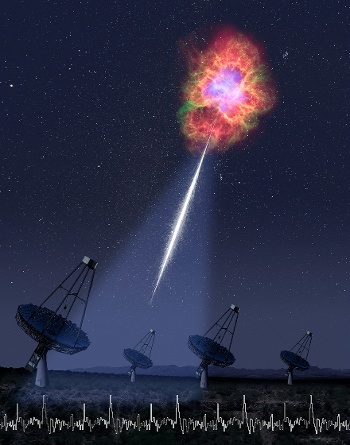Gamma Rays from the Crab Nebula
October 19, 2011
You can assume that a
scientific paper is important if it's published in a notable
journal; and it has ninety-five authors! [1] That's the number of authors on the paper, "Detection of Pulsed Gamma Rays Above 100 GeV from the Crab Pulsar," published in the October 7, 2011, issue of
Science. So, what's the big deal? These are the highest
gamma ray energies ever detected from a
pulsar; so high that that they can't be explained by current pulsar models.[1-6]
Gamma ray emitting pulsars are common. Like all other pulsars, they are rotating
neutron stars, the remnants of
supernovae. Composed entirely of
neutrons, they are extremely dense, having a density slightly greater than that of an
atomic nucleus, which is about 3 x 10
17 kg/m
3. Most pulsars emit radiation at
radio wavelengths, also.
The
Crab Pulsar, located 6,500
light-years from
Earth, is the result of a
supernova explosion that was observed on Earth with the unaided eye in 1054. This supernova explosion, visible for about a week, was recorded by
Chinese and
Native American observers.[3]
The
Crab Nebula, the expanding region of gas ejected by the supernova, is an easy target for
astronomers, so it's been observed at all available
wavelengths, often generating striking images, as in the photograph below.

Hubble Space Telescope image of the Crab Nebula.
This is a mosaic of 24 images of the six-light-year-wide remnant of the supernova explosion of 1054.
(Via Wikimedia Commons))
The Crab Pulsar emits its radiation in twin beams. One beam directs a radiation pulse towards Earth 30.2 times a second because of the star's
rotation. One interesting observation is that the pulse rate is slowing, which also means that the star is spinning down. It's losing rotational energy, since it's emitting energy in the radiation beams.
The Crab Pulsar was found to emit gamma rays when the first spaceborne gamma-ray detectors were launched in 1971. The mechanism is the same as that for
particle accelerators built here, on Earth. Particles moving in curved paths in the huge
magnetic field of the neutron star emit the gamma rays.[2,6] Detailed observations by the
Energetic Gamma Ray Experiment Telescope (EGRET), active from 1991 to 2000, have shown that most of the Crab Pulsar's radiation is emitted by gamma rays with energies greater than 10
MeV.
The successor gamma ray
telescope to EGRET is the
Fermi space telescope, launched on 11 June 11, 2008. I wrote about one of Fermi's discoveries in a
previous article (Cosmic Ice and Galactic Flatulence, November 16, 2010). Although Fermi's detectors will only respond to gamma radiation with energy below 20
GeV, the energy spectrum suggested that things might be happening at higher energies.[2]
The gamma ray telescope, called
VERITAS (Very Energetic Radiation Imaging Telescope Array System), used in the Science study was not a spaceborne instrument. It's a ground-based gamma ray observatory composed of four, twelve
meter telescopes at the
Southern Arizona Whipple Observatory.[6] The telescopes detect the
Cherenkov radiation emitted by high velocity
electron-positron pairs created by gamma rays.[4,6] Cherenkov radiation is the same bluish light seen in
pool-type nuclear reactors.

An artist's conception of the Crab Pulsar with VERITAS.
Gamma rays from the Crab Pulsar create electron-positron pairs with high velocity that produce Cherenkov radiation as they pass through Earth's atmosphere. This creates a cone of visible light detected by VERITAS.
(Image: Jose Francisco Salgado, Adler Planetarium))
VERITAS began full-scale observations in September, 2007, and 107 hours of data were obtained over the course of three years.[4,6] Gamma ray pulses were detected with energy up to 400 GeV,[1] and the pulse width is almost three times shorter than observed for pulses at other gamma ray energies.[3,6] The high energy gamma rays could be described by a
power law, and they appear to be generated more than ten stellar radii from the neutron star.[1]
Says VERITAS Collaboration spokesman,
Rene Ong, a
UCLA professor of
physics and astronomy, "This was very surprising and means this new radiation is probably coming from a different physical region of the star's outer magnetosphere."[6]
This discovery may add impetus for funding of a larger gamma ray observatory, the
Cherenkov Telescope Array (CTA). The CTA will be ten times more sensitive than VERITAS, since it will be composed of dozens of telescopes covering more than a half
square mile.[6]
The 95 authors of the Crab Pulsar paper in Science are from twenty-six institutions in five countries.[6] VERITAS receives funding from the
National Science Foundation, the
U.S. Department of Energy, the
Smithsonian Institution, the
Natural Sciences and Engineering Research Council of Canada, the
Science Foundation Ireland, and the
Science and Technology Facilities Council of the United Kingdom.[5-6]
References:
- The VERITAS Collaboration, "Detection of Pulsed Gamma Rays Above 100 GeV from the Crab Pulsar," Science, vol. 334, no. 6052 (October 7, 2011), pp. 69-72.
- Crab Pulsar's high-energy beam surprises astronomers, BBC News, October 6, 2011.
- Daily Mail Reporter, "Supernova that lit up the skies for a whole month 1,000 years ago still puzzling astronomers," Daily Mail (UK), October 7, 2011.
- Christine Pulliam, "Crab pulsar dazzles astronomers with its gamma-ray beams," Harvard-Smithsonian Center for Astrophysics Press Release, October 6, 2011.
- Bobbie Mixon and Lisa Van Pay, "Crab Pulsar Emits Light at Higher Energies Than Expected," National Science Foundation Press Release No. 11-215, October 6, 2011.
- Kim DeRose, "Crab Pulsar emits light at highest energies ever detected in a pulsar system, scientists report," UCLA Press Release, October 6, 2011.
Permanent Link to this article
Linked Keywords: Scientific; journal; Science; gamma ray; pulsar; neutron star; supernova; neutron; atomic nucleus; radio wavelength; Crab Pulsar; light-year; Earth; supernova explosion; Chinese; Native American; Crab Nebula; astronomer; wavelength; Hubble Space Telescope; light-year; Wikimedia Commons; rotation; particle accelerator; magnetic field; Energetic Gamma Ray Experiment Telescope; electronvolt; MeV<; telescope; Fermi space telescope; GeV; VERITAS; meter; Southern Arizona Whipple Observatory; Cherenkov radiation; electron-positron pair; pool-type nuclear reactors; Jose Francisco Salgado; Adler Planetarium; power law; Rene Ong; University of California, Los Angeles; UCLA; physics and astronomy; Cherenkov Telescope Array; square mile; National Science Foundation; U.S. Department of Energy; Smithsonian Institution; Natural Sciences and Engineering Research Council of Canada; Science Foundation Ireland; Science and Technology Facilities Council of the United Kingdom.